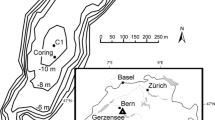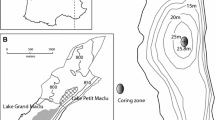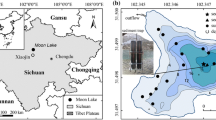Abstract
Taxon-specific stable carbon isotope (δ13C) analysis of chitinous remains of invertebrates can provide valuable information about the carbon sources used by invertebrates living in specific habitats of lake ecosystems (for example, sediments, water column, or aquatic vegetation). This is complementary to δ13C of sedimentary organic matter (SOM), which provides an integrated signal of organic matter produced in a lake and its catchment, and of diagenetic processes within sediments. In a sediment record from Strandsjön (Sweden) covering the past circa 140 years, we analyzed SOM geochemistry (δ13C, C:Natomic, organic carbon content) and δ13C of chitinous invertebrate remains in order to examine whether taxon-specific δ13C records could be developed for different invertebrate groups and whether these analyses provide insights into past changes of organic carbon sources for lacustrine invertebrates available in benthic and planktonic compartments of the lake. Invertebrate taxa included benthic chironomids (Chironomus, Chironomini excluding Chironomus, Tanytarsini, and Tanypodinae), filter-feeders on suspended particulate organic matter (Daphnia, Plumatella and Cristatella mucedo), and Rhabdocoela. δ13C of chironomid remains indicated periodic availability of 13C-depleted carbon sources in the benthic environment of the lake as δ13C values of the different chironomid taxa fluctuated simultaneously between −34.7 and −30.5 ‰ (VPDB). Daphnia and Bryozoa showed parallel changes in their δ13C values which did not coincide with variations in δ13C of chironomids, though, and a 2–3 ‰ decrease since circa AD 1960. The decrease in δ13C of Daphnia and Bryozoa could indicate a decrease in phytoplankton δ13C as a result of lower lake productivity, which is in accordance with historical information about the lake that suggests a shift to less eutrophic conditions after AD 1960. In contrast, Rhabdocoela cocoons were characterized by relatively high δ13C values (−30.4 to −28.2 ‰) that did not show a strong temporal trend, which could be related to the predatory feeding mode and wide prey spectrum of this organism group. The taxon-specific δ13C analyses of invertebrate remains indicated that different carbon sources were available for the benthic chironomid larvae than for the filter-feeding Daphnia and bryozoans. Our results therefore demonstrate that taxon-specific analysis of δ13C of organic invertebrate remains can provide complementary information to measurements on bulk SOM and that δ13C of invertebrate remains may allow the reconstruction of past changes in carbon sources and their δ13C in different habitats of lake ecosystems.




Similar content being viewed by others
References
Appleby PG (2001) Chronostratigraphic techniques in recent sediments. In: Last WM, Smol JP (eds) Tracking environmental change using lake sediments. Volume 1: Basin analysis, coring, and chronological techniques. Kluwer Academic Publishers, Dordrecht, pp 171–203
Appleby PG, Oldfield F (1978) The calculation of lead-210 dates assuming a constant rate of supply of unsupported 210Pb to the sediment. Catena 5:1–8
Bade D, Pace M, Cole J, Carpenter S (2006) Can algal photosynthetic inorganic carbon isotope fractionation be predicted in lakes using existing models? Aquat Sci 68:142–153
Barker PA, Hurrell ER, Leng MJ, Verschuren D, Conley D, Plessens B (2013) The changing carbon cycle of lakes revealed by the stable isotopes of diatom silica: a 25 ka record from Lake Challa, Kilimanjaro. Quat Sci Rev 66:55–63
Brenner M, Whitmore TJ, Curtis JH, Hodell DA, Schelske CL (1999) Stable isotope (δ13C and δ15N) signatures of sedimented organic matter as indicators of historic lake trophic state. J Paleolimnol 22:205–221
Brooks SJ, Langdon PG, Heiri O (2007) The identification and use of Palaearctic Chironomidae larvae in palaeoecolgy. QRA technical guide no. 10. Quaternary Research Association, London
Brunberg A-K, Blomqvist P (1998) Vatten i Uppsala län 1997. Beskrivning, utvärdering, åtgärdsförslag. Rapport nr 8/1998. Upplandsstiftelsen. (in Swedish)
DeNiro MJ, Epstein S (1978) Influence of diet on the distribution of carbon isotopes in animals. Geochim Cosmochim Acta 42:495–506
France RL (1995a) Carbon-13 enrichment in benthic compared to planktonic algae: foodweb implications. Mar Ecol Prog Ser 124:307–312
France RL (1995b) Stable isotopic survey of the role of macrophytes in the carbon flow of aquatic foodwebs. Vegetatio 124:67–72
Frey DG (1964) Remains of animals in Quaternary lake and bog sediments and their interpretation. Adv Limnol 2:1–114
Frossard V, Belle S, Verneaux V, Millet L, Magny M (2013) A study of the δ13C offset between chironomid larvae and their exuvial head capsules: implications for palaeoecology. J Paleolimnol 50:379–386
Frossard V, Verneaux V, Millet L, Jenny J-P, Arnaud F, Magny M, Perga M-E (2014) Reconstructing long-term changes (150 years) in the carbon cycle of a clear-water lake based on the stable carbon isotope composition (δ13C) of chironomid and cladoceran subfossil remains. Freshw Biol. doi:10.1111/fwb.12304
Geller W, Müller H (1981) The filtration apparatus of Cladocera: filter mesh-sizes and their implications on food selectivity. Oecologia 49:316–321
Heiri O, Schilder J, van Hardenbroek M (2012) Stable isotopic analysis of fossil chironomids as an approach to environmental reconstruction: State of development and future challenges. In: Proceedings of the 18th international symposium on chironomidae, Trondheim 4–6. August 2011, Fauna Norvegica 31:7–18
Herzschuh U, Mischke S, Meyer H, Plessen B, Zhang C (2010) Lake nutrient variability inferred from elemental (C, N, S) and isotopic (δ13C, δ15N) analyses of aquatic plant macrofossils. Quat Sci Rev 29:2161–2172
Hollander DJ, McKenzie JA, Hsu KJ, Huc AY (1993) Application of an eutrophic lake model to the origin of ancient organic-carbon-rich sediments. Glob Biogeochem Cycles 7:157–179
Hurrell ER, Barker PA, Leng MJ, Vane CH, Wynn P, Kendrick CP, Verschuren D, Street-Perrott FA (2011) Developing a methodology for carbon isotope analysis of lacustrine diatoms. Rapid Commun Mass Spectrom 25:1567–1574
Jennings JB (1957) Studies on feeding, digestion, and food storage in free-living flatworms (Platyhelminthes: Turbellaria). Biol Bull 112:63–80
Jones RI, Carter CE, Kelly A, Ward S, Kelly DJ, Grey J (2008) Widespread contribution of methane-cycle bacteria to the diets of lake profundal chironomid larvae. Ecology 89:857–864
Kaminski M (1984) Food composition of three bryozoan species (Bryozoa, Phylactolaemata) in a mesotrophic lake. P Arch Hydrobiol 31:45–53
Kiyashko SI, Narita T, Wada E (2001) Contribution of methanotrophs to freshwater macroinvertebrates: evidence from stable isotope ratios. Aquat Microb Ecol 24:203–207
Kolasa J, Tyler S (2010) Flatworms: Turbellaria and Nemertea. In: Thorp JH, Covich AP (eds) Ecology and classification of North American freshwater invertebrates. Academic Press, London, pp 143–161
Leavitt PR, Brock CS, Ebel C, Patoine A (2006) Landscape-scale effects of urban nitrogen on a chain of freshwater lakes in central North America. Limnol Oceanogr 51:2262–2277
Leng MJ, Lamb AL, Marshall JD, Wolfe BB, Jones MD, Holmes JA, Arrowsmith C (2005) Isotopes in lake sediments. In: Leng MJ (ed) Isotopes in palaeoenvironmental research. Springer, Dordrecht, pp 147–184
Luther A (1955) Die Dalyelliiden (Turbellaria Neorhabdocoela), eine monografie. von Tilgmann, Helsingfors
Macko SA, Helleur R, Hartley G, Jackman P (1990) Diagenesis of organic matter—a study using stable isotopes of individual carbohydrates. Org Geochem 16:1129–1137
Merritt RW, Cummins KW, Berg MB (2008) An introduction to the aquatic insects of North America. Kendall and Hunt, Dubuque
Meyers PA, Lallier-Vergès E (1999) Lacustrine sedimentary organic matter records of late Quaternary paleoclimates. J Paleolimnol 21:345–372
Meyers PA, Teranes JL (2001) Sediment organic matter. In: Last WM, Smol JP (eds) Tracking environmental change using lake sediments. Volume 2: Physical and Geochemical Techniques. Kluwer Academic Publishers, Dordrecht, pp 239–269
Mihuc T, Toetz D (1994) Determination of diets of alpine aquatic insects using stable isotopes and gut analysis. Am Midl Nat 131:146–155
Moller Pillot HKM (2009) Chironomidae larvae, biology and ecology of the Chironomini. KNNV Publishing, Zeist
Moog O (2002) Fauna Aquatica Austriaca. Wasserwirtshcaftskataster, Bundesministerium für Land- und Forstwirtschaft, Umwelt und Wasserwirtschaft, Vienna
Okamura B, Hatton-Ellis T (1995) Population biology of bryozoans: correlates of sessile, colonial life histories in freshwater habitats. Cell Mol Life Sci 51:510–525
Perga M-E (2010) Potential of δ13C and δ15N of cladoceran subfossil exoskeletons for paleo-ecological studies. J Paleolimnol 44:387–395
Perga M-E (2011) Taphonomic and early diagenetic effects on the C and N stable isotope composition of cladoceran remains: implications for paleoecological studies. J Paleolimnol 46:203–213
Rau GH (1980) Carbon-13/carbon-12 variation in subalpine lake aquatic insects: food source implications. Can J Fish Aquat Sci 37:742–746
Schimmelmann A (2011) Carbon, nitrogen and oxygen stable isotope ratios in chitin. In: Gupta NS (ed) Chitin. Springer, Netherlands, pp 81–103
Stevenson FJ (1982) Extraction, fractionation, and general chemical composition of soil organic matter. In: Stevenson FJ (ed) Humus chemistry. Genesis, composition, reactions. Wiley, New York, pp 26–54
Turney CSM (1999) Lacustrine bulk organic δ13C in the British Isles during the last Glacial-Holocene transition (14-9 ka 14C BP). Arct Antarct Alp Res 31:71–81
Vallenduuk H, Moller Pillot HKM (2007) Chironomidae larvae, general introduction and Tanypodinae. KNNV Publishing, Zeist
van Hardenbroek M, Heiri O, Grey J, Bodelier P, Verbruggen F, Lotter A (2010a) Fossil chironomid δ13C as a proxy for past methanogenic contribution to benthic food webs in lakes? J Paleolimnol 43:235–245
van Hardenbroek M, Heiri O, Lotter A (2010b) Efficiency of different mesh sizes for isolating fossil chironomids for stable isotope and radiocarbon analyses. J Paleolimnol 44:721–729
van Hardenbroek M, Lotter AF, Bastviken D, Duc NT, Heiri O (2012) Relationship between δ13C of chironomid remains and methane flux in Swedish lakes. Freshw Biol 57:166–177
van Hardenbroek M, Heiri O, Parmentier FJW, Bastviken D, Ilyashuk BP, Wiklund JA, Hall RI, Lotter AF (2013) Evidence for past variations in methane availability in a Siberian thermokarst lake based on δ13C of chitinous invertebrate remains. Quat Sci Rev 66:74–84
Vander Zanden MJ, Rasmussen JB (1999) Primary consumer δ13C and δ15N and the trophic position of aquatic consumers. Ecology 80:1395–1404
Vanderkerkhove J, Declerck S, Vanhove M, Brendonck L, Jeppesen E, Porcuna JM, De Meester L (2004) Use of ephippial morphology to assess richness of anomopods: potentials and pitfalls. J Limnol 63:75–84
Verbruggen F, Heiri O, Reichart GJ, De Leeuw J, Nierop K, Lotter A (2010) Effects of chemical pretreatments on δ18O measurements, chemical composition, and morphology of chironomid head capsules. J Paleolimnol 43:857–872
Wood TS, Okamura B (2005) A new key to freshwater bryozoans of Britain, Ireland and continental Europe, with notes on their ecology. Freshwater Biological Association, London
Wooller MJ, Wang Y, Axford Y (2008) A multiple stable isotope record of late Quaternary limnological changes and chironomid paleoecology from northeastern Iceland. J Paleolimnol 40:63–77
Wooller M, Pohlman J, Gaglioti B, Langdon P, Jones M, Walter Anthony K, Becker K, Hinrichs K-U, Elvert M (2012) Reconstruction of past methane availability in an Arctic Alaska wetland indicates climate influenced methane release during the past ~12,000 years. J Paleolimnol 48:27–42
Zemskaya T, Sitnikova T, Kiyashko S, Kalmychkov G, Pogodaeva T, Mekhanikova I, Naumova T, Shubenkova O, Chernitsina S, Kotsar O, Chernyaev E, Khlystov O (2012) Faunal communities at sites of gas- and oil-bearing fluids in Lake Baikal. Geo-Mar Lett 32:437–451
Acknowledgments
We thank Lotta Frisk Hagström and Kristina Eriksson for valuable historical information about the lake and Arndt Schimmelmann and three anonymous reviewers for their helpful suggestions to improve this manuscript. This research was supported by the Darwin Centre for Biogeosciences, the European Research Council (ERC) Starting Grant project RECONMET (Project No. 239858), and the Swedish Research Council (Project No. VR 2006-3256).
Author information
Authors and Affiliations
Corresponding author
Electronic supplementary material
Below is the link to the electronic supplementary material.
Rights and permissions
About this article
Cite this article
van Hardenbroek, M., Lotter, A.F., Bastviken, D. et al. Taxon-specific δ13C analysis of chitinous invertebrate remains in sediments from Strandsjön, Sweden. J Paleolimnol 52, 95–105 (2014). https://doi.org/10.1007/s10933-014-9780-8
Received:
Accepted:
Published:
Issue Date:
DOI: https://doi.org/10.1007/s10933-014-9780-8




